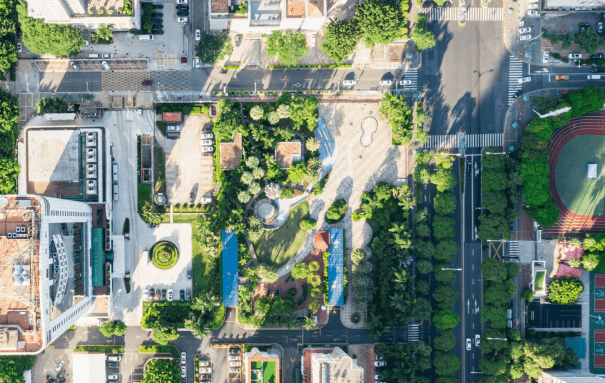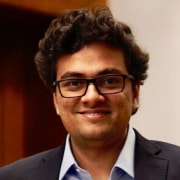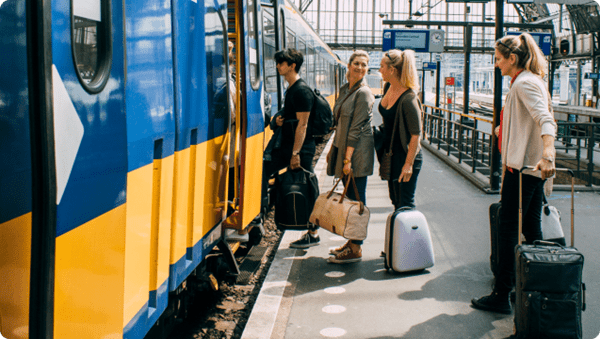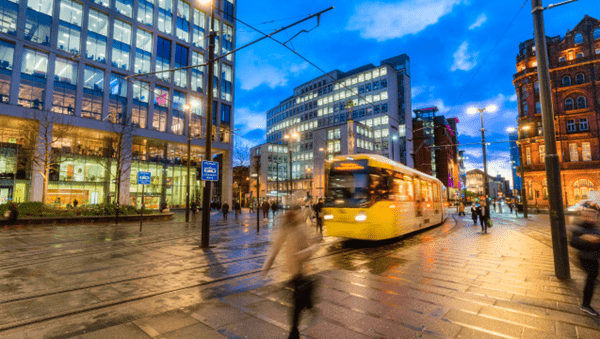In the coastal city of Victoria, in British Columbia, Canada, nestled on the southern tip of Vancouver Island, the challenges of maintaining and safeguarding infrastructure have been a recurring theme throughout its history. From the tragic collapse of the Point Ellice Bridge in 1896 to the present-day concerns over aging infrastructure, the city has long been in need of innovative solutions to ensure the safety and reliability of its vital structures. In this episode of Better Cities by Design, host Davion Ford has an in-depth conversation with Harsh Rathod, the co-founder and CEO of Niricson, a company that is revolutionizing how critical infrastructure, such as bridges and dams, is inspected and managed.
You have not accepted cookies yet
This content blocked. Please accept marketing cookies. You can do this here.
Subscribe on your favourite platform
As the episode unfolds, listeners gain insights into the challenges posed by traditional inspection methods for infrastructure assets and the pressing need for more reliable and efficient processes. Harsh Rathod provides an overview of Niricson's technology, including DRONIC and AUTOSPEX, which digitize the inspection process and utilize artificial intelligence to identify defects and track changes over time. The conversation also highlights Niricson's focus on making infrastructure safer and more reliable, as well as their current global expansion and their exciting partnership with Arcadis.
Join us for this episode to learn more about the future of infrastructure security and the transformative work Niricson is doing to make critical infrastructure safer and more reliable. Tune in to get an inside look at the importance of technology and innovation in safeguarding our cities.


The Arcadis global podcast
Better Cities by Design
Episode transcript:
We recognize that not everyone is able to listen to our podcast, which is why the show is also available in text. If you would prefer to read what happened in the show instead of listening, please click the link below for the episode transcript.
-
Read full transcript
00:05
Davion Ford
Welcome to Better Cities by Design, a podcast brought to you by Arcadis, where we talk to change-makers who are working to make our cities better places for people to live, work and play. I’m your host Davion Ford. In this episode, we headed to the beautiful coastal city of Victoria in British Columbia, Canada, where we spoke with Harsh Rathod, the Co-Founder and CEO of Niricson. Niricson is at the forefront of digital solutions for enhancing how critical infrastructure like bridges and dams are inspected for safety and reliability, revolutionizing the way infrastructure is managed and safeguarded. Stay tuned for a conversation at the intersection of technology and infrastructure, where Harsh talks about his company’s mission to make infrastructure safer.
01:00
Davion Ford
We start by rewinding to the close of 19th century. The city of Victoria in Canada underwent a period of significant growth and transformation. Nestled on the southern tip of Vancouver Island, Victoria, with its picturesque landscapes and burgeoning urban center, became a beacon of progress and opportunity in the Pacific Northwest. The city's strategic location and natural harbor made it a hub for maritime trade and commerce, attracting settlers, merchants, and entrepreneurs seeking to capitalize on its promising future. Amidst this backdrop of expansion and development, the Point Ellice Bridge stood as a vital artery connecting communities and facilitating the flow of goods and people across the city. But on May 26th, 1896, just before 2:00 pm, the Consolidated Electric Railway Company's No. 16 streetcar, was overcrowded with 143 passengers on their way to view the naval parade in celebration of Queen Victoria's birthday. As the streetcar crossed the Point Ellice Bridge, the bridge collapsed, and the streetcar crashed into the river killing 55 people. The collapse was attributed to poor bridge maintenance and insufficient safety checks. The disaster raised profound questions about the engineering standards at play in the design of bridges as well as the resilience of vital structures in Victoria. Fast forward to the present day and standards have become much more rigorous. Nevertheless, the poor state of infrastructure still poses significant risks for people all around the world. Bridge collapses still occur, for instance in the Fern Hollow Bridge in Pittsburgh, Pennsylvania, which collapsed in 2022. And the American Society of Civil Engineers has warned that US's infrastructure is in need of significant attention. To learn more, let’s hear from Arcadis’ Sales Director for Mobility, Felipe Lima.
03:05
Felipe Lima
The findings from the Infrastructure Report Cards for both the United States and Canada highlight the challenge both countries face when it comes to aging infrastructure and safety concerns. In Canada, more than 39 percent of bridges are currently classified as being in poor or fair condition. In the United States, the situation is equally concerning. With over 600,000 bridges across the country, 42 percent of them are at least 50 years old. And more than 46,000 of those bridges, are classified as structurally deficient, meaning they are in 'poor' condition. Despite their compromised state, tens of millions of people are relying on these bridges each day.
03:53
Davion Ford
As cities grapple with the urgent need for innovative solutions to ensure that critical infrastructure is safe and resilient, companies like Niricson are stepping up to meet the challenge. Leveraging cutting-edge technologies such as robotics, computer vision and acoustic technology, combined with AI, Niricson, offers ways to conduct structural inspections that are more reliable, more thorough and based on actionable data. And this can help asset operators to move from having to risk need to respond to a calamity to taking preventative steps to avoid having disaster strike in the first place. And this is the reason that Arcadis has formed a partnership with Niricson to help organizations that operate and maintain bridges to a better job of inspecting them. For more on this here again is Arcadis’ Felipe Lima.
04:45
Felipe Lima
Niricson's expertise in robotics, computer vision, and AI combined with Arcadis' deep asset knowledge and strategic vision creates a powerful synergy. This collaboration allows us to conduct faster, more cost-effective, and more accurate inspections, paving the way for safer and more resilient bridges across the globe.
05:11
Davion Ford
To learn more about the work that Niricson is doing, it’s my pleasure to invite Harsh Rathod, the Co-Founder and CEO of Niricson, to the show.
05:28
Davion Ford
Harsh, welcome to Better Cities by Design.
05:31
Harsh Rathod
Thanks for having me. Yeah.
05:32
Davion Ford
So Harsh, let's start off by having you tell our listeners a bit about yourself. And what your company Niricson does.
05:39
Harsh Rathod
Yeah, thank you. My name is Harsh Rathod. I'm CEO and co-founder of Niricson. My background is in Civil and Structural Engineering. I did my PhD in structural health monitoring. So I mean Niricson’s foundation really started during my PhD actually. So several years ago. At Niricson, what we have done is we have developed DRONIC, which is our data collection technology. We patented it, it's also an architecture that allows us to, of course, collect the data on some of the bridges, dams, and critical infrastructure. And then we take this data into the software that we have developed, which is AUTOSPEX. So we feed this data and create actual defects masks using the software. So these are the two things that we have developed at Niricson, DRONIC and AUTOSPEX.
06:29
Davion Ford
You've established Niricson in part really to make this inspection process for assets more reliable and more efficient. Can you explain what the traditional methods of, for instance, bridge safety inspection would look like? And what specific challenges this would present?
06:45
Harsh Rathod
Yeah, no. So in our civil engineering industry, right, especially when it comes to inspection, things being done in the same way from the centuries, right, with the minimal improvement, and inspection, of course, not left out in this particular aspect. So if we look at bridges, for instance, right, the way it's been inspected, is really with the manual methodology. So you know, a group of technicians or engineers would go out there on structure with pen, paper and hammer, they would actually climb the structures when they don't have access, or they would actually use binoculars to look for any sort of defects. As I say, because they are carrying pen and paper, they will actually draw this defense, but they see sometimes actually, they climb the structure using rope scaffolding, sometimes cranes, snooper truck, so they have to, of course, close the traffic as well. And then after they map everything out, they actually also look for some sort of defects that the subsurface they can see for that peg. So we use a hammer, strike the concrete surface with the hammer and try to listen to the drummy sounds, which we call it delamination, which is a subsurface defect. And they'll use that you know, and hear that we can fine tune ear and try to find, okay, is it the hollow concrete or sound concrete, and again, they write down the observation, they'll take all this observation back into the office and wrap up the report. So as you could imagine, they will do this every couple of years. So you will have, of course, reports, which are again, not super standardized, because every time different people are doing this, just leave it hard for someone else to really look at these reports and compare these results. So again, it's really hard to, to see what's the trend of this structure in terms of health. So these are some of the challenges that is possessed. And because of that, the structure, of course, keeps aging, and we are not able to maintain it in a predictive or a proactive way. But, you know, it really goes into kind of a reactive mode, right. And that, of course, increases the risk.
08:59
Davion Ford
It's a bit wild, when you start to think that all over the world, we've been relying on structures that have typically been inspected in such a way that's so subject to human error. I guess in that respect, maybe it's more of a wonder that we don't have infrastructure failures happening all the time. So now, we've understood, let's say, the traditional way of conducting one of these inspection processes for bridges and other types of assets. So what's different about what you folks at Niricson do?
09:28
Harsh Rathod
So the major element here is really digitization by because, as I explained with the traditional method, it's quite manual. So we are not digitizing these things right again, with pen paper. So here at Niricson, what we have tried doing is actually digitizing the entire inspection process from end to end. So these structures are created into the digital world. By now what we wanted to do is go and stop there, having a really nice digital model. You is not the same level of value where we really wanted it to be. For instance, you could look at these 3d models to the orthographic images on a computer screen, but then what? So what we wanted to do is actually create some sort of data output on the top of this 3d models and to the orthographic images in such a manner that it could be useful by the engineer. So what we have done is actually invented, of course, our AI based inspection process on the top of this, right, so not only we are actually utilizing unmanned aerial vehicles, which we of course, known as drones, to collect the data, all automatically digitize the structure, but on top of that, utilizing artificial intelligence to create defects map on it, right. So, rather than relying on a person's judgment to identify, Okay, this is a defect or not, what we are teaching is we are teaching it to the machine by millions of defects that is being collected that okay, you know, this is a crack, this is some sort of spoil, for example. And then now the computer is recognizing this, rather than, again, relying on just the human. Now, we are not saying that we are removing the human component completely out of this, but instead actually making the human process, you know, completely smart. So let the computer do the entire thing first, and then of course, have the human intervention in such a manner that we made the entire process much smarter compared to what's out there. So if I were to summarize this, you have the drones going out there, in the field. It's all pre-programmed. So drones are flying all automatically. It's collecting the data, you're stitching all this data together, they are all created into the digital world. So you have digital models. Now on top of that, we are creating the information that is useful for the engineers. So again, all using artificial intelligence and machine learning, creating all these defects masks automatically. They are all quantified. They're all on cloud. So you could collaborate. Anybody in the world can actually sign in and can take a look at this, they can see how things are changing all the period of time. Because as I said, these are all standardized drone flights pre-programmed, he could do it the same way as you have done it in a repeated manner. And can see even the smallest change in the structure and can establish the train line, and can take it to the next level in terms of prediction, rather than just being reactive. Now imagine you're doing this for multiple structure, not just the one structure, right? So imagine the cities, because this is all about better cities by design, right? So if you imagine, majority of the structures, we are utilizing this type of tech, now you can start understanding the trend line in terms of the help of this large critical assets, like of course, we're talking bridges here. But you could deploy this for all the other assets as well. Now, as an asset manager, you can start understanding where I should be deploying my capital, because I can see how structures are changing over that period of time, how I can reduce the risk in terms of course, financial risk in terms of risk associated with the safety of people risk associated with the safety of disruptors, all of that right, and then of course, pull the trigger, when it's really necessary in terms of reducing this risk. So that's what Niricson brings on the table. And we'll get into the technology a little bit later, exactly how the technology works. But this is at high level.
13:56
Davion Ford
My next question for you is about the name of the company Niricson. It's a unique name. What's the inspiration behind that? And also, I happen to know that you also have a particular inspiration around the creation and founding of the company. Could you talk about both of those things?
14:13
Harsh Rathod
So Niricson, right. So Niricson is a is a Sanskrit name. That is actually the meaning of Niricson and the Sanskrit name is basically detailed instruction. And I really wanted to have a name that actually is related to what we've been doing right. And, of course, you know, my origin is from India. And Sanskrit is historical language for us. So we wanted to keep this very unique name. So when we say this name in Sanskrit is actually ‘nireekshan’. Right is not exactly Niricson. But I also wanted to give a little bit of flavor on to that right. So that's how we came up with Niricson name. Now, how did we start this company? So initially, when I was working on my PhD, I didn't have so much intention of commercializing this technology. But of course, wanted to take this technology more on the on the research level. But in 2016, there was a bridge collapse that happened in India, we had about 28 people died. Fortunately, none of my family members were involved, although they were actually utilizing that particular bridge, which was first between Mumbai and Goa. So that was a big trigger for me. And it was quite emotional for me, because it could have been my family members right on that day. So that was a big motivation for me that I've been working on this technology, development of this technology for a number of years now. So I think I have a great opportunity to disrupt this market, in terms of what's been happening in the industry and what I can bring on the table. And then of course, a word, this type of disasters, right? One bridge at a time, that was a goal at that time. And we've come a long way, since that.
16:05
Davion Ford
Harsh that's such a great inspiration for the work that you do. And obviously a terrible tragedy that those people lost their lives back in 2016. On that bridge, I certainly hope that the work that you're doing also in conjunction with us here at Arcadis, which we're going to talk about in a bit, well, in some way pay kind of an homage or something good will come out of that horrible situation. One more historical note, let's say, another blast from the past so to speak, I happen to know that you opened up shop back in 2020, right? And, of course, that's forever going to be imprinted in all our minds as the year of COVID-19 really hit us, that had to have been a really challenging time to start a company. But I understand that the pandemic actually also helped spur on your business. Can you talk about that a bit?
16:53
Harsh Rathod
Yeah. So initially, of course, we face a lot of challenges during the pandemic, like all the other startup companies, right? When it comes to funding, hiring the right people, and all of that, of course, because we have to maintain the remote environment, it's sometimes really hard to understand the, you know, humans personality without meeting the person. And you know, of course, when we have to make the hiring decisions, labor harder, right, and of course, communication, all those stuff. So we face those challenges. But one particular one was, this particular industry is where a lot of the stuff happens, you know, in the trade shorts, right and building the relationship with the client, because most of the business is done by done with the government. So when we are dealing with the government, it's important that they don't think this is just one of the companies just coming out. But we need to make sure that there is a credibility behind that. And you know, those type of things can happen when you present your work in the conference. But again, all the conference kind of went on the remote environment. So that was very challenging for us. But on the other side, which is, of course, the positive part is when it comes to inspection, it was really hard for engineers to go out in the field into the groups, or even climb structures and in the utilizing snooper trucks and everything, very difficult for them. So I'll give you an example of at that time, of course, we were focusing quite a bit on dam. So one of the dams that we were looking at, and we got the contract at that time, the inspectors and the reason why we got the contract, because the client wanted to do actually traditional inspection at that time, and they were trying to send you know, 15 people's team, remotely. And we actually live in a kind of a tent environment for couple of days. And that was impossible, right at that time. So when we pitched this idea that, okay, you do everything utilizing the drones. And then you can actually quantify all the defects and everything like how you're doing it traditionally don't need rope access or anything, don't need cranes. And they were quite excited about this. Of course, for them, the barrier was that, okay, this new technology haven't been deployed. We don't know about the results and all of that, but that actually allowed them to take the risk because there is no other choice. Right. So that was a major milestone for us, we were able to deploy the technology in a much faster pace. And we were able to demonstrate that this technology is fantastic in terms of what we're able to get compared to the traditional methodology. And since then, we've been working with multiple hydro dam owners around the globe. So that was a huge positive aspect for the company during the pandemic.
19:40
Davion Ford
So I'm starting to pick up on a bit of a thrill line for the Niricson’s and story about being able to take some difficult circumstances, whether it's that bridge collapse that happened in India or the pandemic, and being able to spin that into something positive and to make some real opportunities out of it. So I think that that's really, really great. Okay, So now let's get into it in terms of the specifics about how some of these technologies work. So you've got AUTOSPEX and also DRONIC. Can you explain what they are, what they do and how they're actually working on a practical level to be more effective tools at preventing risk and infrastructure?
20:20
Harsh Rathod
Yeah. So let's start with DRONIC first. So DRONIC is our data collection technology and architecture, which we have patented it, it has multiple layers of data that is being collected by either drones or any sort of robot. So again, we are trying to remove the human element out of this, so that we can actually maintain the repeatability. So these are all pre-programmed, either robots or drones, right? It collects three layers of data, it collects visual information, collects thermal data set, and then collects the acoustic information. In the future, we can add multiple layers as well. So it's kind of open ended. So visually data really allows us to understand what's happening on the surface level of the structures to reach our optical images. Thermal is basically in for images. So that gives us temperature information allows us to understand what's happening on subsurface of the structure, but we are looking at about 50 millimeters from the top. And then there is acoustic, which is again, our proprietary tech, which is our sensor payload that goes on the drone, and actually strikes the concrete and collects the sounding information, which is a very unique thing, because earlier a person would go out there with hammer and strike the concrete. Now actually the drone is going out there on concrete surface and striking the concrete and using the signal processing, we're understanding what's happening, you know, that sub surface level to the structure right, which again earlier was done by fine-tuned ears. Now, we are combining these three layers of data from surface level information to sub surface level information all the way to 200 millimeter. So when it comes to acoustic data, we are going up to 200. So far, first 100 millimeter of data set, we are having very high level of confidence in detecting delamination of works. But when it comes to of course, going beyond 100 millimeter, the confidence level goes down. The part of the reason is the intensity of the striking, right because of the drones have limited payload capacity. Now what do we do with this data set. So again, as I said earlier, we wanted to take this to the next level. So we wanted to process this data in such a manner that civil engineers or structural engineers can utilize this data and make the decision. So we actually fuse these layers, we apply artificial intelligence and machine learning to identify deficiencies or defects in the structure, it could be anything from cracking, spalling, vegetation seepage, any sort of leakage that is happening on the structure, all of that is detected all automatically. These are all quantified, these are being tracked over the period of time. And then they are all available for visualization, on AUTOSPEX by an engineer. And again, they can be visualized anywhere from the world, because these are all cloud based data set. So like how you sign into Facebook, you would sign on to this platform, you can take a look at where there are issues in the structure, because these are quantified information, you could identify where the risks are, how things are changing over the period of time. And then of course, make any sort of maintenance or rehabilitation decision right. Now good thing about this is because this is cloud based, not only civil engineers can utilize this for making the decision, but actually maintenance engineers who are going out during the field, doing the actual repair work can also utilize this platform and see, okay, how does the structure look like after the maintenance system? So yeah, this is DRONIC and AUTOSPEX combined.
24:12
Davion Ford
So Harsh, you know that here at Arcadis, we're really excited about our partnership with Niricson looking at bridge health, but bigger picture than even just that for Niricson and and all of the work that you're doing. I know that the focus is really on making infrastructure safer. And I think that anybody out there listening to this should really be into the notion that we're going to be working to make bridges and other structures that folks are using as safe as possible. And so thank you to you and your team at Niricson and for all of the work that you're doing. And also thank you so much for joining the podcast.
24:47
Harsh Rathod
Yeah, no, thank you very much for having me. I really appreciate that and yeah this partnership with Arcadis is something super critical for the industry because what we bring on the table is the technology. But on the other side is Arcadis, which is the brainpower, the engineering expertise. And I think the combination of these two things is super powerful. And then it's something the industry really needs. So I'm super excited about this partnership. And once again, thanks for having me.
25:20
Davion Ford
That’s it for this episode of the show! I want to thank Harsh Rathod from Niricson for joining us. Please, stay tuned for future episodes as we continue to bring change-makers to the table who are driving progress in urban development. And if you haven't done so already, be sure to subscribe and check out our other episodes. I’m Davion Ford, and you’ve been listening to Better Cities by Design, a podcast brought to you by Arcadis, the world’s leading company delivering sustainable design, engineering, and consultancy solutions for natural and built assets. You can learn more by visiting our website arcadis.com or by following Arcadis on LinkedIn or Facebook. And please, stay curious, get inspired, and remember, the future belongs to those who dare to make a difference in the cities we call home.







